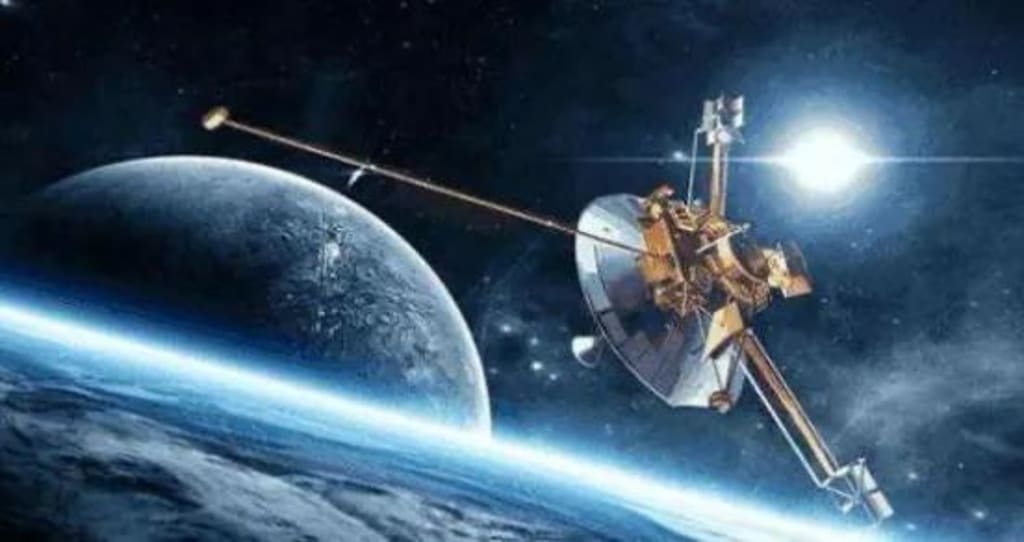
To say that the history of man-made probes that make humans on the planets of the universe is the Voyager, the legendary and mysterious cosmic excursion that brought us new knowledge of the universe. Voyager probe is the United States launched in 1977, as two planetary probes. The original name of the "Mariner Project" is "Mariner 11" and "Mariner 12". Costing $350 million to build, the two probes weigh 815 kg each and have roughly the same structure, with cosmic ray sensors, plasma sensors, magnetometers, wide-angle, narrow-angle television cameras, infrared interferometers, and other 11 kinds of scientific instruments, which cleverly use the gravitational effect of giant planets, so that they change their orbits in time, to achieve the purpose of simultaneous detection of multiple planets and their satellites.
In 1977, one of the most sacred years in history, Jimmy Carter became the new president of the United States, Elvis Presley died of a heart attack, the new Apple computer was founded, the last Apollo moon landing was over, and Voyager's legendary journey had just begun. The first artificial probe ever launched was Sputnik I, but because the rocket thrust was too small to get rid of the solar system gravity, even to Neptune took half a lifetime, scientific experts are racking their brains to try to solve the problem. Hey, in 1961, when a legendary Minovich solved the problem that people at that time felt impossible to calculate, that is, the "three heavenly bodies". Under the pressure of $1000 an hour with 7090 computers on, Minovich calculated that the probe could fly faster under the propulsion of cosmic gravity, and this theory is called the gravitational slingshot effect.
Another legend, Gary Flanders, who was only a sabbatical student studying for his degree, concluded that Saturn, Jupiter, Uranus, and Neptune would be on the same side of the Sun during 1975-1976, meaning that the probe would only need to send once to see all these planets under the gravitational slingshot effect, or it would have to wait another 176 years for this sighting. The sighting will occur.
With the space technology of the time probes would have taken 12 years to reach the four planets, and N6ASA had never built a spacecraft with a working life of more than a few months. How to build a spacecraft that could tolerate errors and work continuously became the biggest problem in the space industry at that time.
After the problem of research and development funding emerged, the new spacecraft needed a spokesperson, and at the suggestion of a young storyteller named Carl Sagan, each spacecraft needed to place some information about Earth to gain public attention and stimulate the public's imagination, which later became Voyager's unique gilded copper singing saucer feature.
While passing by Saturn, Voyager discovered that Saturn's halo was split into small rings with many gaps and that there were some delicate rings held together by a small moon called Shepherd, and after combining several photographs of the halo's secondary bars and calculating that the secondary bars were apparently rotating around Saturn under the influence of Saturn's magnetic field, and while observing Saturn miraculously discovered a planet with an atmosphere similar to Earth's, Titan Titan, a planet with a density similar to that of Earth. Unfortunately, despite a deliberate course change, Voyager 1's camera could not penetrate Titan's atmosphere so it was impossible to tell if there was any sign of life on the planet.
So here must be a very curious question, the spacecraft camera malfunction how to solve, hey, and then fly a person up to fix it? And at that time there was such a situation, Voyager 2 was flying away from Saturn when the camera's pan had a stuck problem, so how should be repaired? Since it would take five years to reach the next target, Uranus, no one could tell if Voyager 2's camera was fixed without any target to focus on in the meantime. Uranus, 2 billion miles from Earth, was extremely poorly lit, and all the space engineers risked certain baldness by working day and night to reprogram the spacecraft to take clear pictures while it was in motion, and eventually succeeded. The exploration of Uranus was disappointing to many because Uranus has no heat source due to its interior, no energy drive in its atmosphere, and no energy drive-in atmosphere. The planet's surface appears particularly calm, although Uranus did not gain but still found in it a cool three-dimensional jigsaw puzzle of the smallest satellite, Miranda.
The largest planet in our solar system
Neptune is the largest planet in our solar system. When flying over the north pole of Neptune, Voyager 2 had to pass within 1 second due to the flight inclination and high speed, and this high precision posed a huge problem to the spacecraft navigation system at that time. At the risk of only having one chance to point Voyager's camera at the area where the storm might occur for two weeks, scientists finally succeeded in capturing the images everyone expected to see, where clouds were moving in different directions, moving close to the speed of sound, and an extremely complex atmosphere, but there was more to Neptune than that, there was also the amazing discovery of the solar system's coldest moon, Chardon. Despite this, intermittent geysers have been found on the surface of Chardon, with nitrogen eruptions up to several miles high.
The two Voyagers collected 500 million exoplanet data, the most in human history, and Voyager 1, 13 years after leaving Earth, was ordered to take a family photo of all the planets in the solar system at a signal power of 100 billionths of a billionth of a watt.
The significant difference in the distance between the two probes and the Sun as they traverse the edge of the solar system in exactly opposite directions suggests that the solar system is not a simple symmetrical large sphere as originally thought, but should approximate an ellipsoid.
The nature of the solar system
Many of you here surely only know the name of the solar system, but do not know what its nature is. The solar system has the Sun as its core, and the entire "sphere of influence" of the Sun is called the "heliosphere" in astronomy, which is also a virtual bubble within the reach of high-energy particles ejected by the Sun, which can also be called the solar wind. When the solar wind "collides" with interstellar matter outside the solar system, it begins to decelerate abruptly at the "surge boundary", so this deceleration is seen as a sign of the beginning of the solar system edge. Further out, the force of the solar wind gives way to the force of extrasolar interstellar matter, and this outermost region is called the solar wind sheath, or "heliosheath".
After Voyager 1 flew away from Saturn in 1981 and turned toward Serpens to date, the probe was calculated to be too far from the Sun to harness solar energy. It is now operating at less than 300 watts, which is only enough to power a bright light bulb.
So now, what about Voyager 1, just on April 17, 2019, New Horizons took a picture of Voyager 1 at a distance of about 7.5 billion kilometers from Earth, because the two probes are 18 billion kilometers apart therefore could not see him clearly in the star field, but still know exactly its position by radio tracking.
Voyager is the farthest man-made object from Earth, the first space probe into the solar system, it will sail in the vast universe and constantly send back to mankind previously unexplored strange information about outer space. After that, it will bid farewell to mankind, drifting silently in the universe forever.
See here I wonder if there are friends like me moved to tears, Daini is not the most interested in technology products, but here I think Voyager is alive, he deserves our admiration, those who pay for the country, for the world of space scientists, you worked hard.
About the Creator
C Niecy
Opening up a whole new vision of science to you






Comments
There are no comments for this story
Be the first to respond and start the conversation.